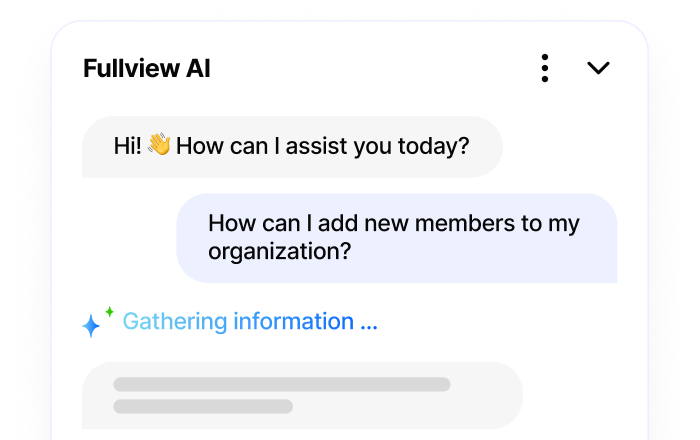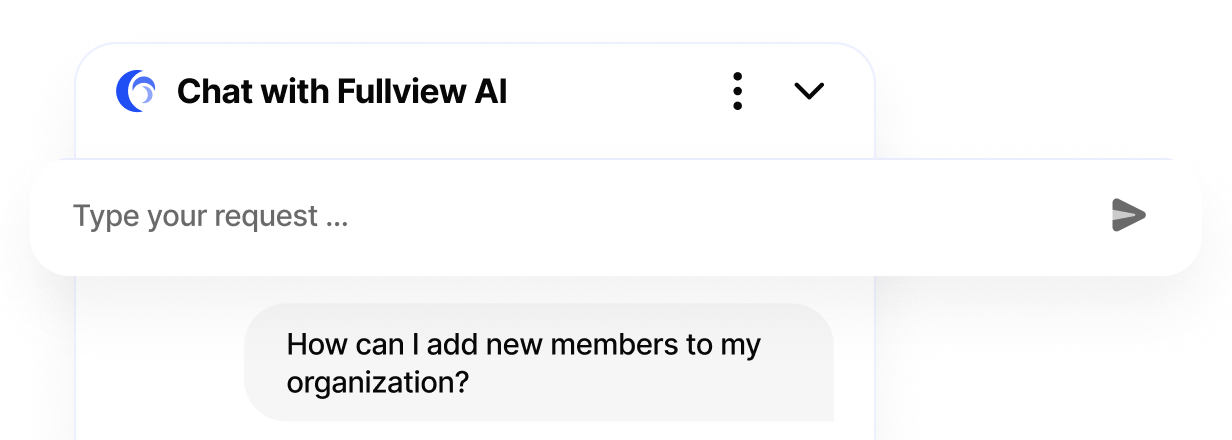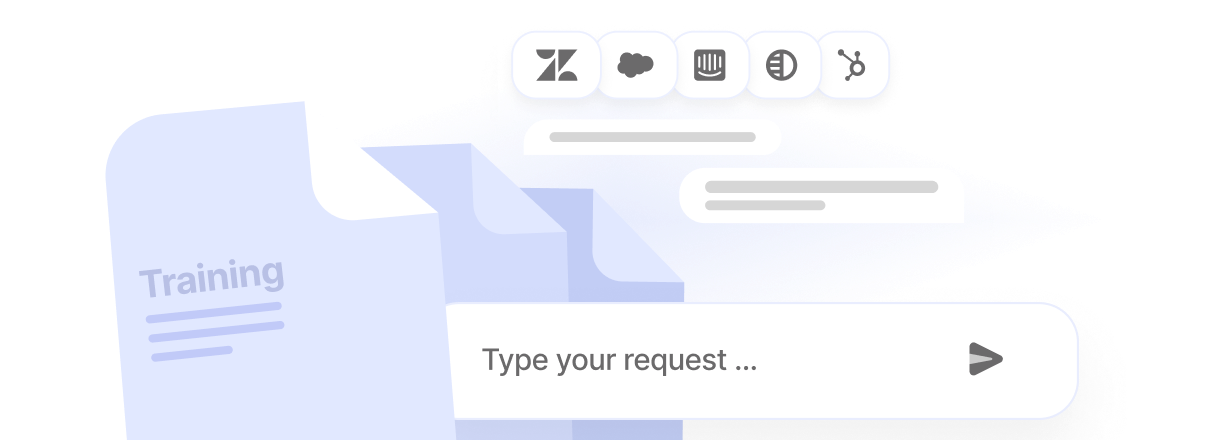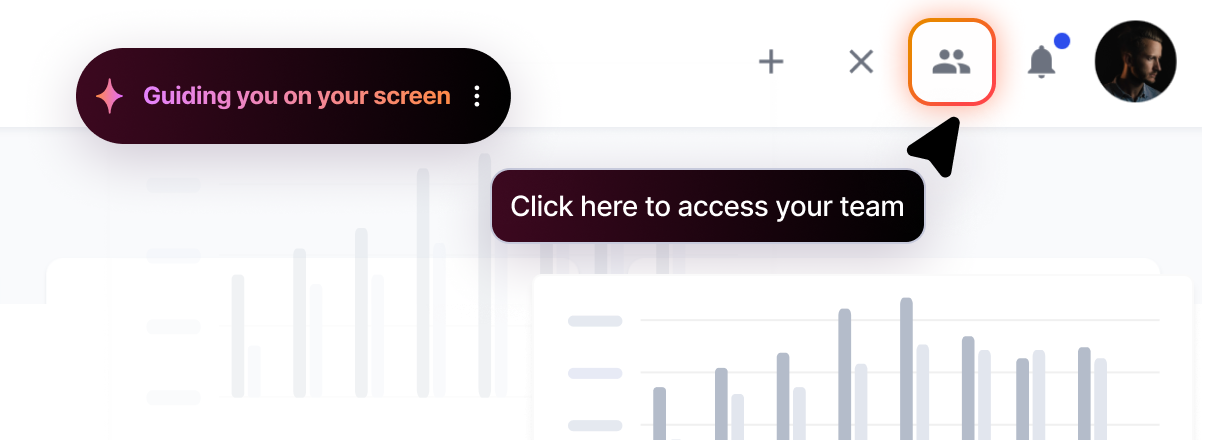TLDR: Customer experience has become the primary competitive battleground, with 89% of businesses competing on CX rather than product or price. AI powered customer support will handle 95% of interactions by 2025, while companies investing in visual guidance and autonomous agents see 61% greater revenue growth and $3.50 return for every $1 invested.
The customer experience landscape is undergoing its most dramatic transformation in decades. These 110+ statistics reveal both unprecedented opportunity and existential risk for organizations managing complex software products and customer relationships. The data shows clear winners emerging: companies implementing AI-powered customer experience with visual guidance capabilities, while laggards face the reality that poor CX puts $3.8 trillion in global sales at risk.
How AI Autonomous Agents Are Revolutionizing Customer Support in 2025
AI Adoption Has Reached Critical Mass
The era of experimental AI in customer service is over. The technology has matured into operational reality with measurable business impact:
- 95% of customer interactions are expected to be AI-powered by 2025 (Tidio)
- 80% of companies will have adopted AI-powered chatbots for customer service by 2025 (Gartner)
- 85% of customer interactions will be managed without human intervention by 2025 (Gartner)
- 71% of organizations regularly use generative AI in at least one business function (IBM)
- 63% of CX leaders plan to increase AI investments within the next year (Zendesk)
Autonomous Agent Performance Delivers Measurable ROI
Companies implementing autonomous AI agents report dramatic improvements across key performance metrics:
- 87% reduction in average resolution times when using AI customer service (Master of Code)
- 13.8% increase in customer inquiries handled per hour by agents using AI tools (Nielsen Norman Group)
- $3.50 return for every $1 invested in AI customer service implementations (average ROI)
- Up to 8x ROI achieved by leading AI customer service adopters (Zendesk)
- 30% reduction in operational costs from agentic AI implementations by 2029 (Gartner)
The Visual Guidance Revolution
Beyond traditional chatbots, 2025 marks the emergence of AI agents that can see and interact with applications:
- More than 90% of consumers want to use video and screen sharing for customer support (LogMeIn)
- Companies using co-browsing software record 61% greater revenue growth compared to competitors (Novelvox)
- Visual information is processed 60,000 times faster than text by the human brain (3M Corporation)
- Video onboarding reduces support tickets by 35% in the first month (TechTarget)
- Co-browsing sessions show 50% increase in customer engagement compared to traditional support (Novelvox)
Fullview's autonomous AI agents can see your application interface, guide users visually, and take actions, delivering instant, effective help with just one line of code.
How Customer Expectations Have Shifted Toward Speed and Self-Service
Immediate Response Is Now Table Stakes
Customer patience has effectively disappeared, creating both pressure and opportunity for SaaS companies:
- 90% of consumers consider immediate response essential for customer service questions (Zendesk)
- 83% of customers expect to interact with someone immediately when contacting a company (Salesforce)
- 51% of consumers prefer interacting with bots over humans when seeking immediate service (Zendesk)
- 67% of customers prefer self-service to speaking with support agents for simple issues (CustomerGauge)
- 54% of consumers don't care how they interact with a company, as long as problems are fixed fast (Salesforce)
Mobile-First Support Becomes Essential
The shift to mobile-first customer interactions requires fundamental changes in support delivery:
- Over 50% of web traffic comes from mobile devices (Statista)
- 33% of customers use mobile devices to reach customer service (Nextiva)
- 40% of eCommerce sales come from mobile devices (BigCommerce)
- 43% of global eCommerce sales will be mobile commerce by 2024 (Insider Intelligence)
- Mobile commerce will account for 73% of all eCommerce sales by 2025 (Statista)
Self-Service Preferences Create Scalability Opportunities
Customer preference for autonomous problem-solving creates both cost savings and satisfaction improvements:
- 81% of customers attempt to resolve issues themselves before contacting support (HubSpot)
- 88% of customers expect brands to have online self-service portals (Document360)
- Self-service interactions cost just pennies compared to $6-12 for live human support (Knowmax)
- Companies providing customer self-service can save $3 million annually (Raffle)
- 77% of customers view brands more positively when they provide effective self-service options (KnowledgeOwl)
The Financial Case for CX Investment Is Overwhelming
Revenue Impact of Superior Customer Experience
The ROI data for customer experience investments shows consistent, dramatic returns across industries:
- SaaS companies can expect to increase revenue by $1 billion from CX investments (SuperOffice)
- Companies focusing on CX see 80% increase in revenue compared to CX laggards (Zendesk)
- Customer-centric brands report 60% higher profits than competitors failing to focus on CX (Zendesk)
- Companies with strong CX strategies see 1.5x higher revenue growth and 1.8x higher profitability (Renascence)
- One-point CX improvement can drive over $1 billion in additional revenue for large organizations (Forrester)
The Cost of Poor Customer Experience
The financial impact of subpar customer experiences represents existential threat to sustainable growth:
- $3.8 trillion in global sales at risk from bad customer experiences (Qualtrics)
- 53% of consumers will cut spending with a company after one bad experience (Qualtrics)
- 50% of customers will switch to competitors after a single poor interaction (Zendesk)
- 92% of customers will completely abandon a company after 2-3 negative experiences (SuperOffice)
- Only 1 in 26 customers will complain about a bad experience. The rest churn silently (SuperOffice)
Customer Retention and Lifetime Value Impact
Superior CX directly translates to improved retention metrics and customer lifetime value:
- Companies with strong omnichannel strategies retain 89% of customers vs. 33% for weak strategies (Renascence)
- Omnichannel customers have 30% higher lifetime value than single-channel users (Wisernotify)
- Customer-obsessed companies achieve at least 10% revenue growth (41% vs. 10% for less mature companies) (Forrester)
- Organizations demonstrating CX-revenue correlation are 29% more likely to secure additional CX budgets (Gartner)
- 73% of customers say CX is the number one factor when deciding whether to purchase from a company (Zendesk)
Industry Benchmarks Reveal Performance Standards for Excellence
Support Response Time Benchmarks
Performance data shows significant variation across industries, revealing competitive opportunities:
- Top 5% of technology companies resolve issues within 17 hours (Jitbit)
- Overall industry average resolution time: 3 days 10 hours (Jitbit)
- First contact resolution rates should target 70-80% for efficient support operations (Call Centre Helper)
- 1% FCR improvement reduces operating costs by 1% while increasing satisfaction by 1% (Jitbit)
- Average customer service response time across industries: 12 hours (Nextiva)
Customer Success and Retention Benchmarks
Customer success and retention benchmarks provide clear targets for excellence:
- The median technology company maintains 101% net revenue retention (SaaS Capital)
- Top-quartile performers achieve 111% net revenue retention (SaaS Capital)
- Companies with superior CX grow revenues 5 times faster than competitors with inferior experience (Forrester)
- Technology companies typically spend 8% of annual recurring revenue on support (SaaS Capital)
- Best-in-class organizations maintain customer satisfaction scores above 4.5/5 (Benchmarkit)
Cost Efficiency Standards
Leading organizations achieve superior performance while maintaining cost discipline:
- AI implementation reduces labor costs by up to 90% for routine customer service tasks (Dialzara)
- Support agents with AI tools handle 13.8% more inquiries per hour (Nielsen Norman Group)
- Organizations pairing agents with virtual assistants handle 7.7% more simultaneous chats (Master of Code)
- AI-driven customer service reduces operating expenses by 25% on average (Desk365)
- Companies with efficient CX see average cost per contact of $2.70 vs. $8.00 industry average (Convin)
Fullview integrates seamlessly with existing helpdesks like Intercom, Zendesk, and Salesforce while adding autonomous AI agents and visual guidance capabilities that improve these benchmarks dramatically.
How Proactive Support Prevents Issues Before They Happen
Proactive Service Becomes Standard Practice
The shift from reactive to predictive support represents fundamental change in customer expectations:
- 67% of customer service teams now proactively reach out to clients (The Future of Commerce)
- 87% of customers appreciate proactive customer service solutions (Zendesk)
- By 2025, proactive customer service teams will outnumber reactive interactions (Gartner prediction)
- 95% of proactive customer service efforts improve customer retention rates (IBM)
- Proactive support leads to 20-30% reduction in call center volume over 12 months (CX Trends)
Predictive Analytics Drive Prevention
AI-powered systems identify and resolve issues before customers report them:
- 25% reduction in support tickets when implementing proactive monitoring (IBM)
- Proactive customer service reduces operating costs by 25% (Zendesk)
- 88% of CX leaders consider proactive engagement critical for customer retention (Medallia)
- Predictive analytics improve customer satisfaction by 15-20% (Renascence)
- Companies using predictive CX see 30% improvement in retention (McKinsey)
Omnichannel Integration Drives Revenue Growth and Customer Satisfaction
Unified Experience Across All Touchpoints
Seamless omnichannel experiences become competitive necessities rather than differentiators:
- 73% of shoppers use more than one channel during their buying journey (Firework)
- Only 60% of brands offer customer service across three or more channels (Nextiva)
- Companies with highly effective omnichannel engagement experience 9.5% annual revenue growth vs. 3.4% for weaker strategies (Renascence)
- Omnichannel customers spend 30% more than single-channel shoppers (Wisernotify)
- Omnichannel strategies improve customer lifetime value by 30% (Renascence)
Channel Integration Requirements
Modern customers expect context preservation across all interaction points:
- 86% of customers expect seamless handoffs between channels (Salesforce)
- 75% of consumers expect consistent experiences across all channels (Zendesk)
- Purchase and engagement rates are 250% higher in omnichannel campaigns vs. single-channel (Wisernotify)
- 89% customer retention rate for strong omnichannel strategies vs. 33% for poor implementations (Renascence)
- 82% of high-performing organizations use the same CRM platform across service, sales, and marketing (Salesforce)
Voice AI and Conversational Interfaces Transform Support Delivery
Voice Technology Adoption Accelerates
Voice-based AI interactions gain momentum as comfort levels increase across demographics:
- Voice assistant usage projected to reach 8 billion AI-powered devices by 2025 (Teneo)
- 41% of people with smart devices use voice search as often as possible (Teneo)
- 42% of CX leaders see generative AI influencing voice-based interactions in the next two years (Master of Code)
- Voice-based conversational AI projected to cut agent costs by $80 billion by 2026 (Master of Code)
- 74% of consumers say voice AI would highly improve their experience when interacting with AI (Zendesk CX Trends)
Conversational AI Market Growth
The conversational AI market expands rapidly as technology matures and adoption increases:
- Conversational AI market expected to grow 22% annually between 2020-2025 (Deloitte)
- Global conversational AI market projected to reach $14 billion by 2025 (Deloitte)
- 57% of business leaders see conversational chatbots delivering large ROI on minimal investment (MIT Technology Review)
- 80% of executives report measurable improvements from implementing conversational AI (MIT Technology Review)
- Conversational AI adoption increased 67% year-over-year in customer service applications (Crescendo)
Personalization Drives Customer Loyalty and Revenue Growth
Individualized Experiences Become Expected
Customers now expect every interaction to be tailored to their specific context and history:
- Companies excelling in personalization generate 40% more revenue from personalization efforts (McKinsey)
- 76% of customers expect personalization in their interactions with brands (Zendesk)
- 71% of customers expect companies to deliver personalized interactions (McKinsey)
- AI-powered personalization drives up to 15% increase in revenue (Renascence)
- 80% of customers are more likely to purchase from brands offering personalized experiences (Onramp)
Personalization Technology Requirements
Effective personalization requires sophisticated data integration and AI capabilities:
- 66% of consumers say they will share personal data if it elevates their customer experience (Redpoint)
- 86% of B2B customers expect companies to be well-informed about their personal information during service interactions (Gartner)
- Companies that grow faster drive 40% more revenue from personalization than slower-growing counterparts (McKinsey)
- 62% of consumers agree that personalized recommendations are better than general ones (Zendesk)
- 84% of customers want to be treated like a person, not a number (Salesforce)
Fullview's AI agents understand customer context and application state, enabling personalized visual guidance that adapts to individual user needs and technical environments.
Strategic Investment Priorities for Technology Leadership
Technology Stack Integration
Successful CX transformation requires platforms that unify rather than fragment the customer experience:
- Companies implementing unified CX platforms see 25% improvement in customer satisfaction (Salesforce)
- Organizations with integrated tech stacks achieve 19% faster revenue growth (Salesforce)
- 85% of the Fortune 500 use integrated AI solutions to shape their customer experience future (Microsoft)
- Companies with strong data integration capabilities see 36% higher profits (McKinsey)
- 66% of CEOs report measurable business benefits from generative AI initiatives (IDC)
Budget Allocation and ROI Expectations
CX investment priorities show clear patterns among high-performing organizations:
- 80% of CX leaders plan to increase customer service budgets over the next year (Zendesk)
- Investment in AI solutions and services projected to yield $22.3 trillion cumulative impact by 2030 (IDC)
- Every dollar spent on AI generates an additional $4.90 in the global economy (IDC)
- Companies investing in CX technology see payback periods of 6-18 months (Forrester)
- Organizations with mature CX programs achieve 5.1x revenue growth vs. beginners (Onramp)
FAQ: Customer Experience Statistics and Implementation for Technology Companies
What percentage of customer interactions will be AI-powered by 2025?
According to multiple industry studies, 95% of customer interactions are expected to be AI-powered by 2025 (Tidio), with 85% managed without human intervention (Gartner). Gartner specifically predicts that by 2029, agentic AI will autonomously resolve 80% of common customer service issues.
How much ROI can companies expect from CX investments?
Companies implementing AI customer service see average returns of $3.50 for every $1 invested, with leading organizations achieving up to 8x ROI (Zendesk). Organizations focusing on customer experience see 80% higher revenue growth compared to CX laggards, with customer-centric brands reporting 60% higher profits.
What are the key performance benchmarks for customer support?
Top-performing companies resolve issues within 17 hours while maintaining first contact resolution rates of 70-80%. The median technology company achieves 101% net revenue retention, with top-quartile performers reaching 111%. Best-in-class organizations maintain customer satisfaction scores above 4.5/5.
How important is visual support compared to traditional text-based help?
Visual information is processed 60,000 times faster than text by the human brain, making visual support exponentially more effective. Companies using co-browsing software record 61% greater revenue growth, while more than 90% of consumers want to use video and screen sharing for support, yet less than 40% of organizations offer these capabilities.
What's the cost difference between AI and human customer support?
Self-service interactions cost just pennies compared to $6-12 for live human support, while AI implementation can reduce labor costs by up to 90% for routine tasks. Support agents using AI tools handle 13.8% more customer inquiries per hour, with organizations pairing agents and virtual assistants managing 7.7% more simultaneous chats.
How do customers feel about AI versus human support agents?
51% of consumers prefer interacting with bots over humans when seeking immediate service, while 79% of agents believe AI co-pilots supercharge their abilities. However, 71% still prefer human agents for complex issues, suggesting the optimal approach combines AI automation with seamless escalation to human experts equipped with advanced tools.
Take Action: The CX Transformation Window Is Closing
The statistics reveal an unmistakable truth: customer experience has become the primary competitive battleground, with 89% of businesses competing on CX rather than product or price. Companies that delay implementing AI-powered customer support with visual guidance capabilities risk permanent competitive disadvantage as customer expectations solidify around instant, intelligent assistance.
The opportunity is immediate and measurable: organizations implementing comprehensive CX platforms that combine autonomous AI agents with visual guidance see 61% greater revenue growth, $3.50 return for every dollar invested, and dramatic improvements in customer satisfaction and retention metrics.
For organizations managing complex software products and customer relationships, the choice is clear: invest now in platforms that can see customer applications, provide visual guidance, and integrate seamlessly with existing helpdesk systems, or risk joining the companies that lose 50% of customers after a single poor experience.
Fullview represents the cutting edge of this transformation, offering autonomous AI agents that can see your application, guide users visually, and take actions on their behalf. With seamless integration into Intercom, Zendesk, and Salesforce, plus implementation requiring just one line of code, it's the fastest path to next-generation customer support that delivers both immediate ROI and sustainable competitive advantage.
Ready to join the 89% of companies competing on customer experience? The data shows the path forward; execution speed will determine which organizations thrive in the AI-powered customer experience era.
Sources: Data compiled from Zendesk CX Trends 2025, Gartner Customer Service Research, IBM Think Institute, Salesforce State of Service, McKinsey Customer Experience Studies, Forrester CX Research 2025, Qualtrics Experience Management Institute, and 50+ additional authoritative industry sources.








.webp)
